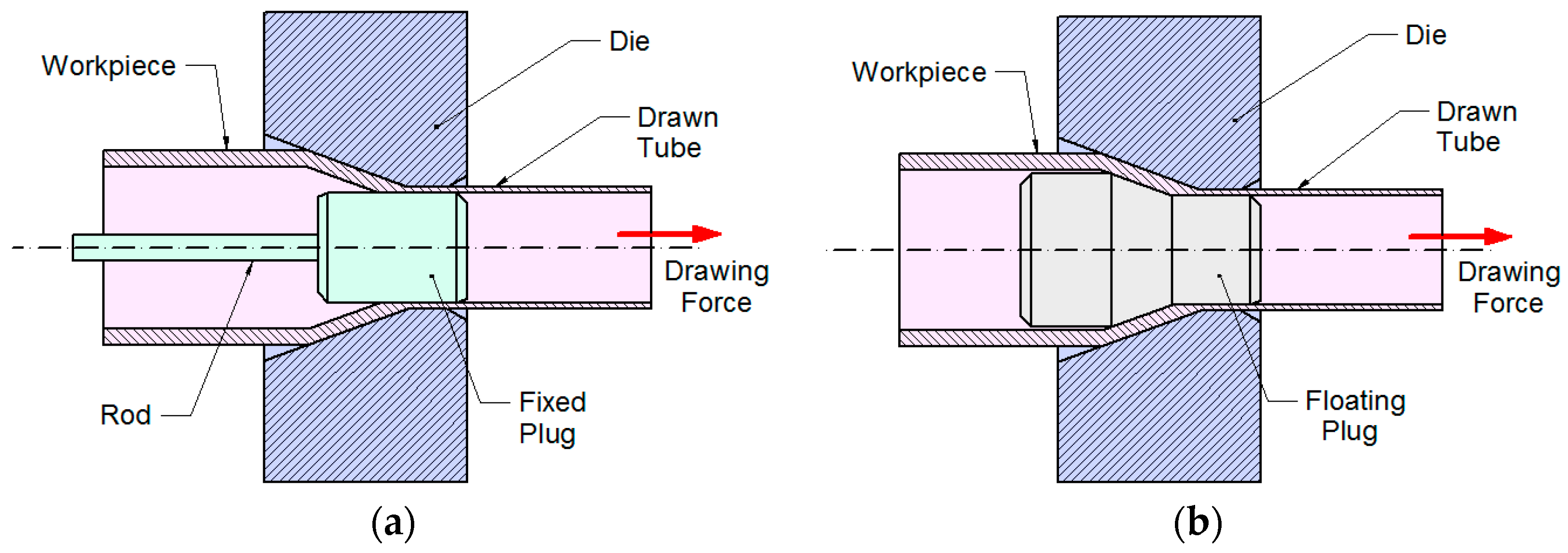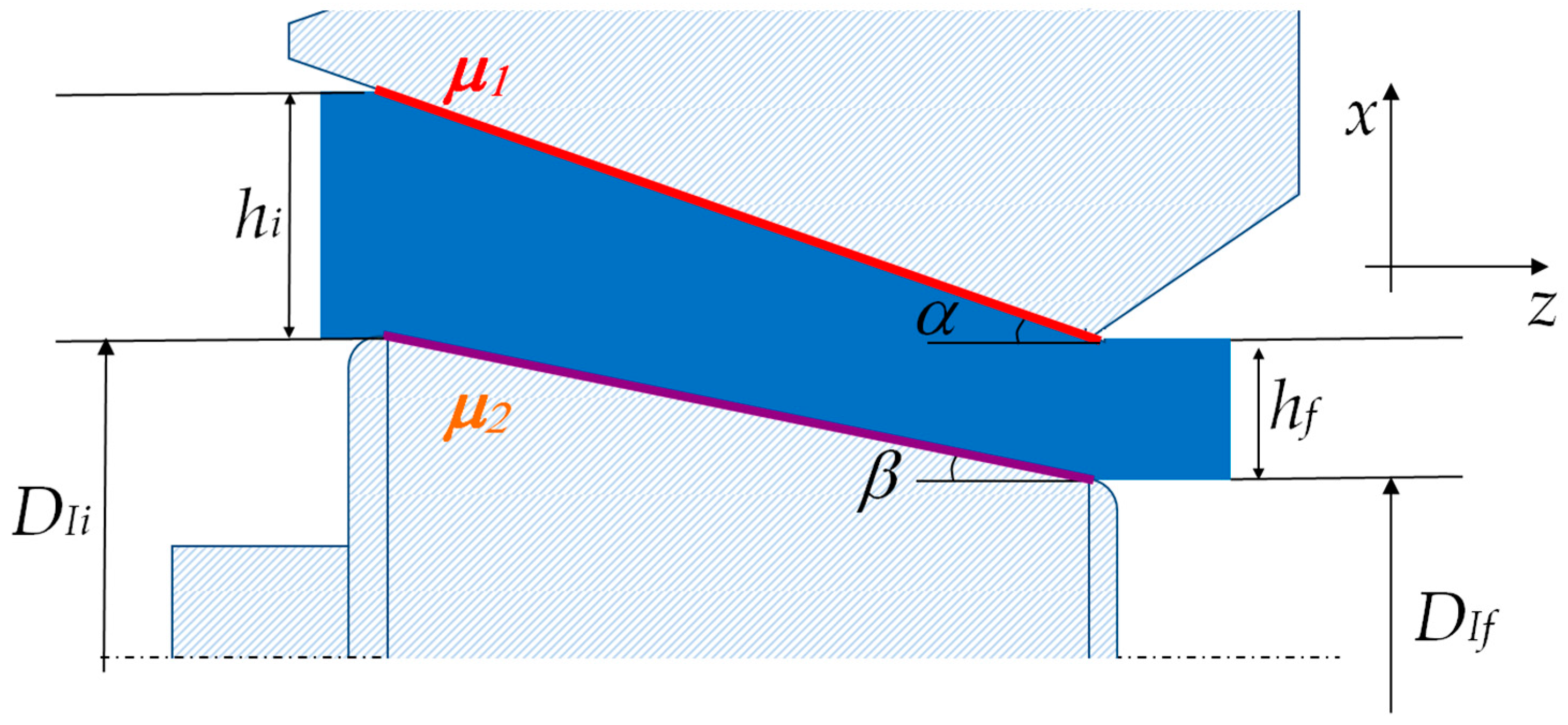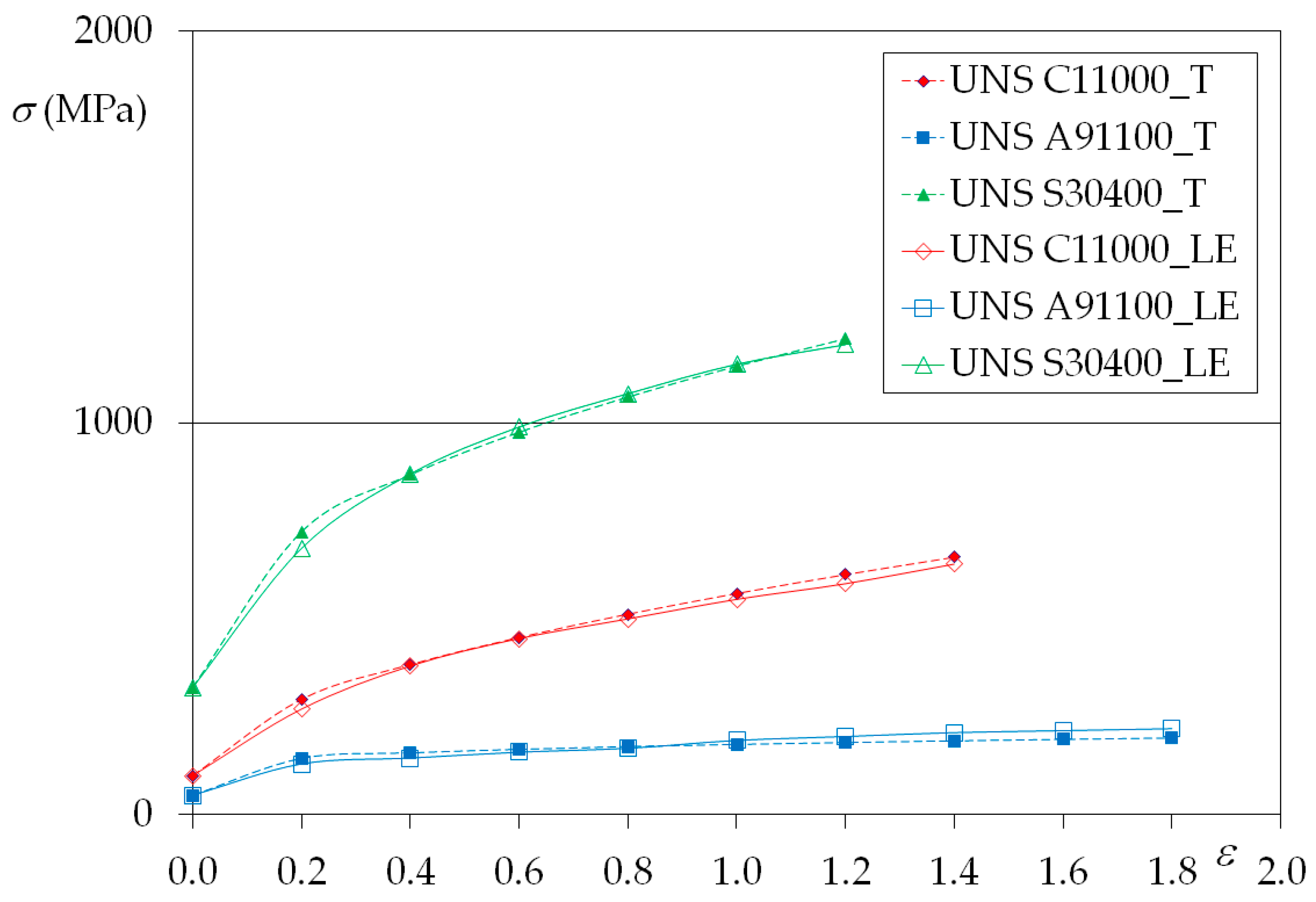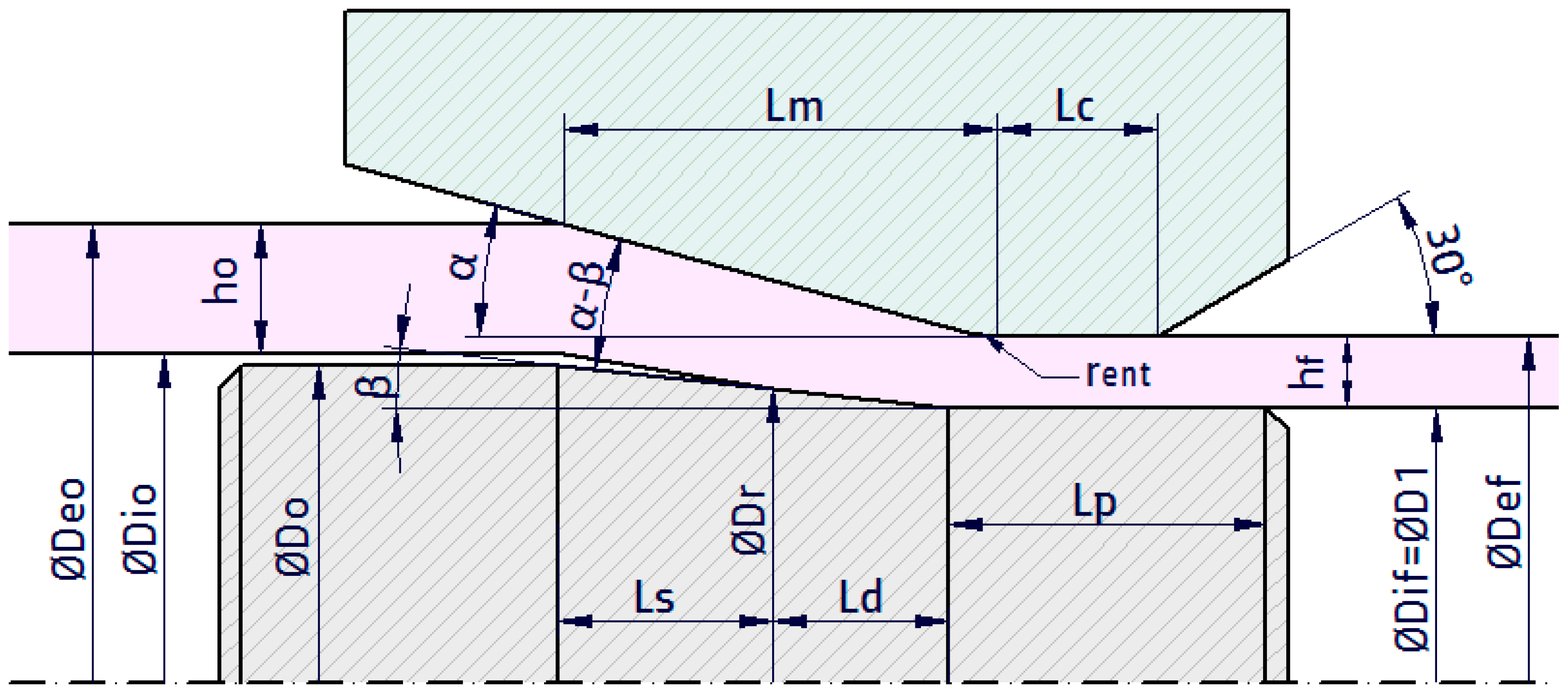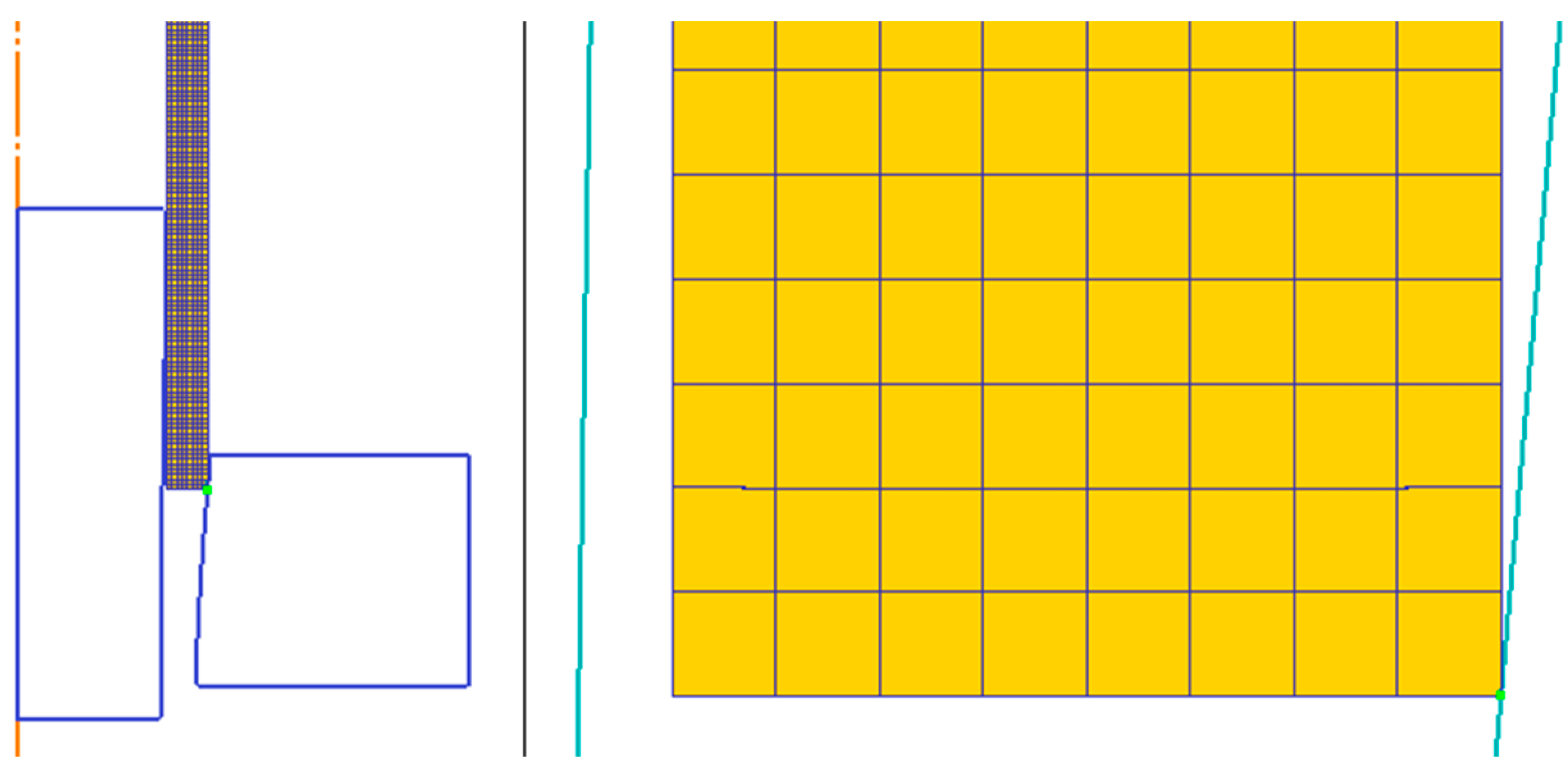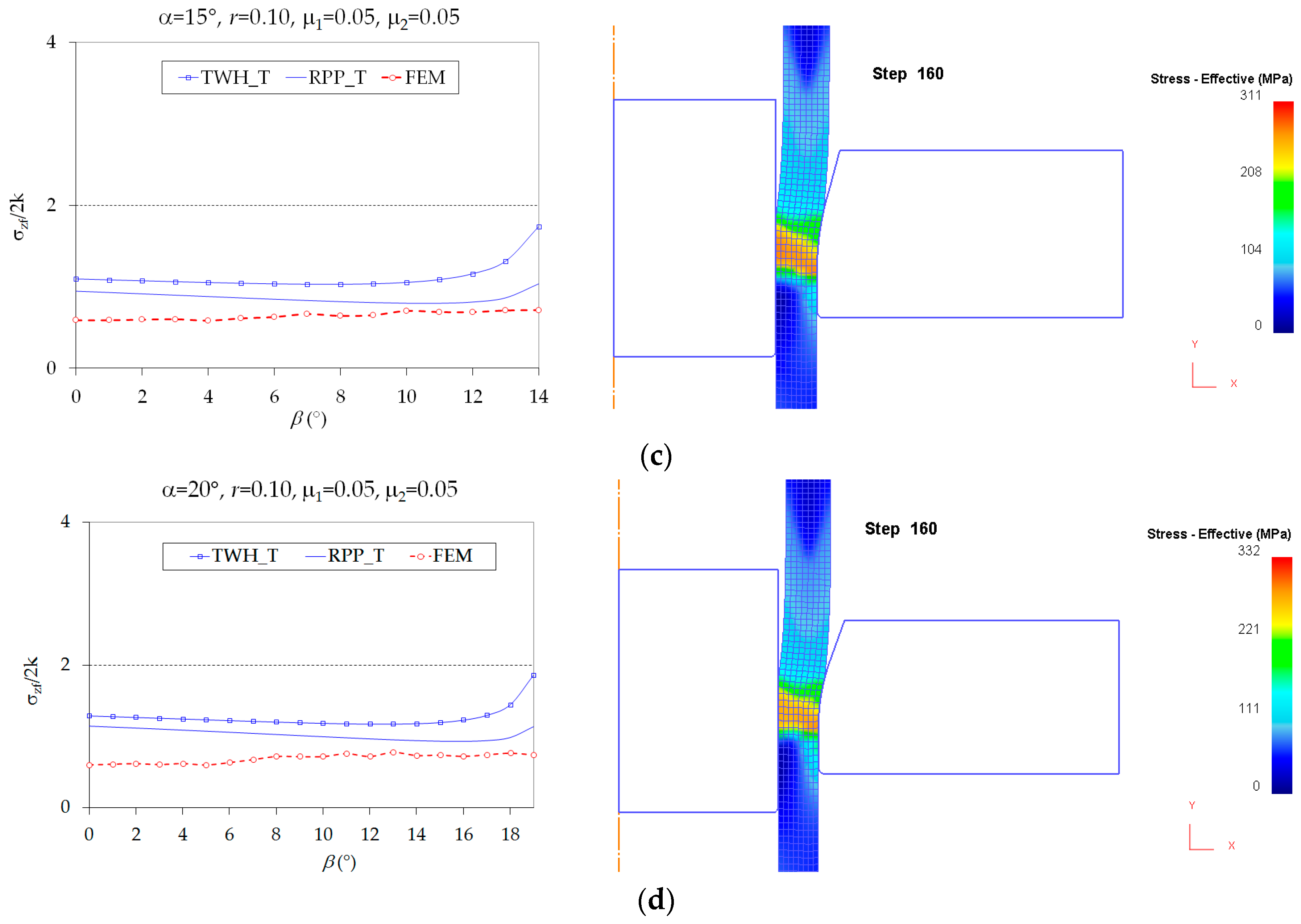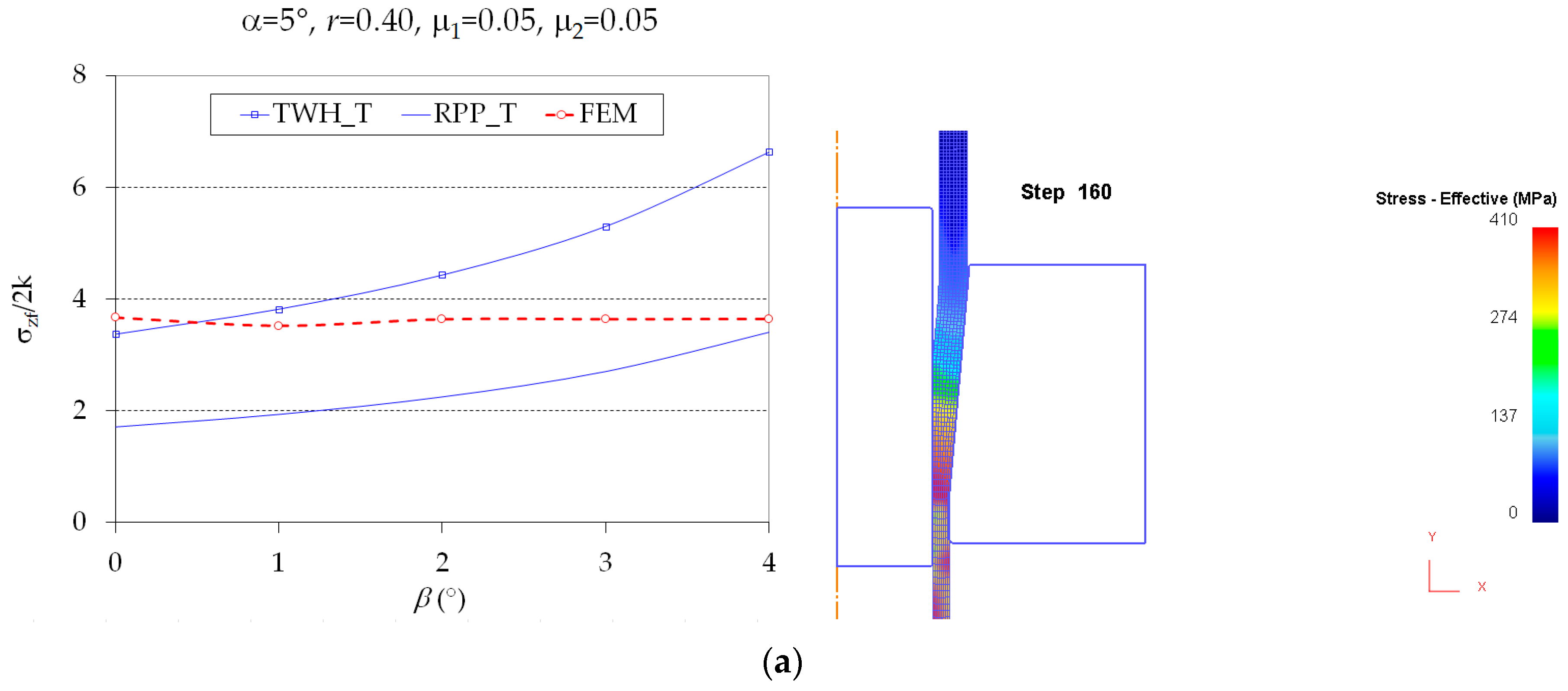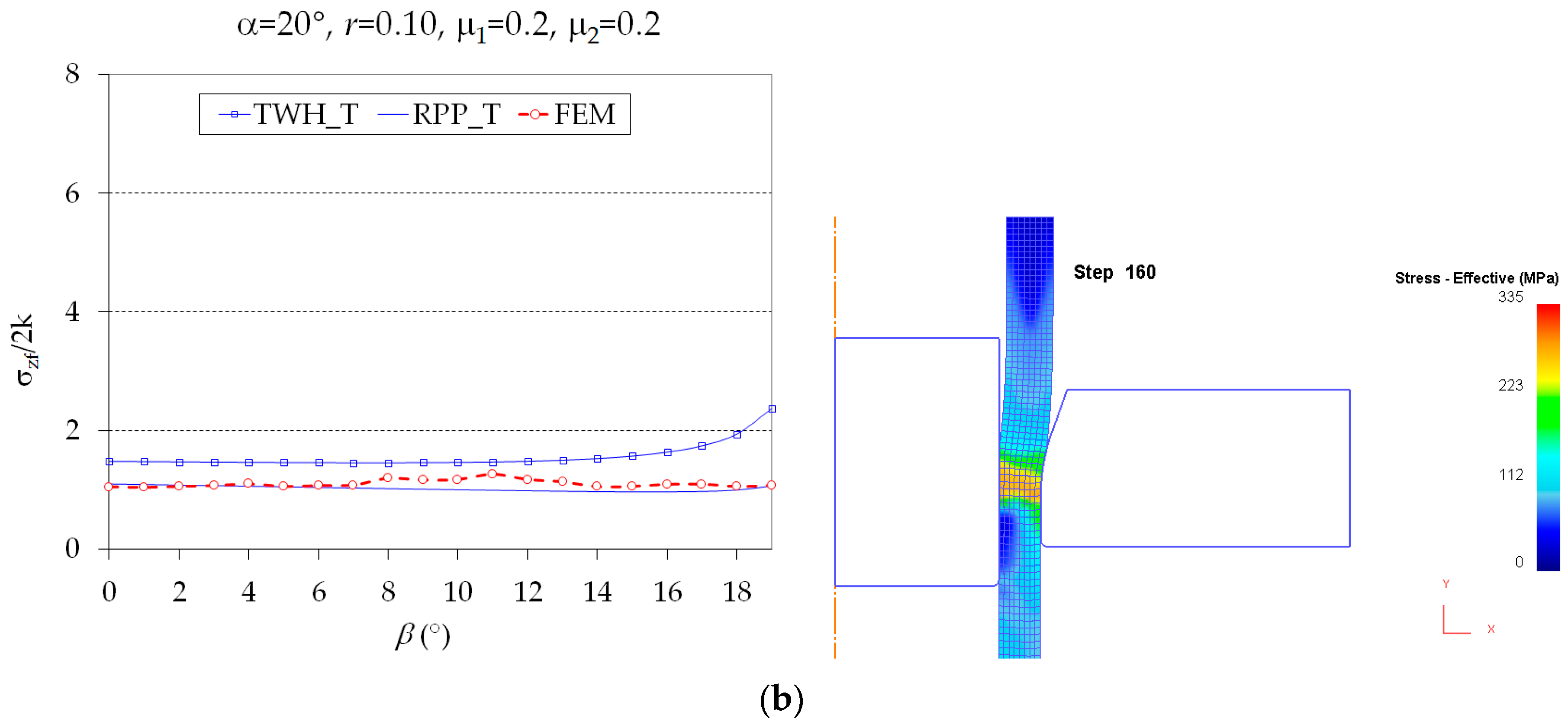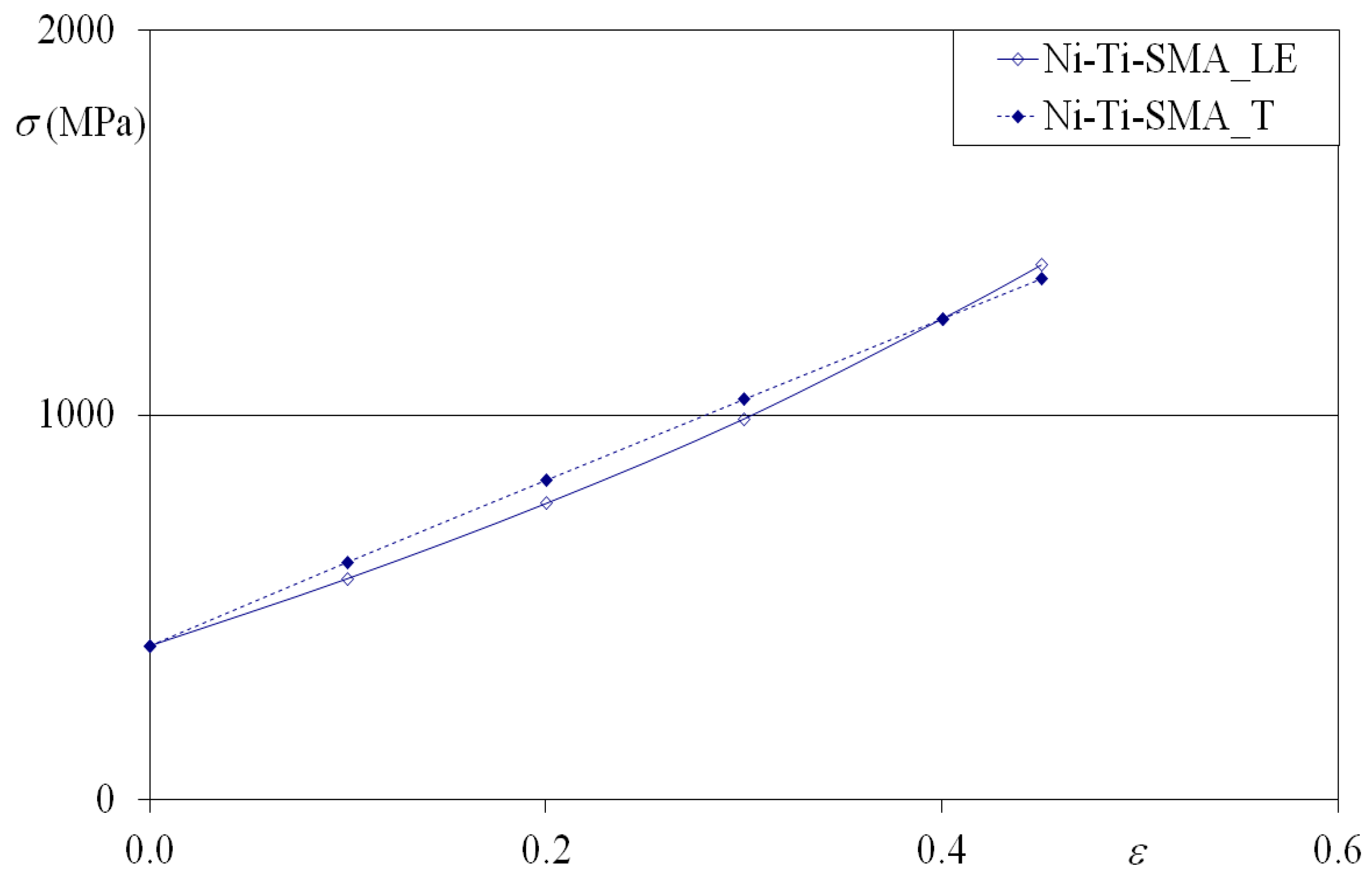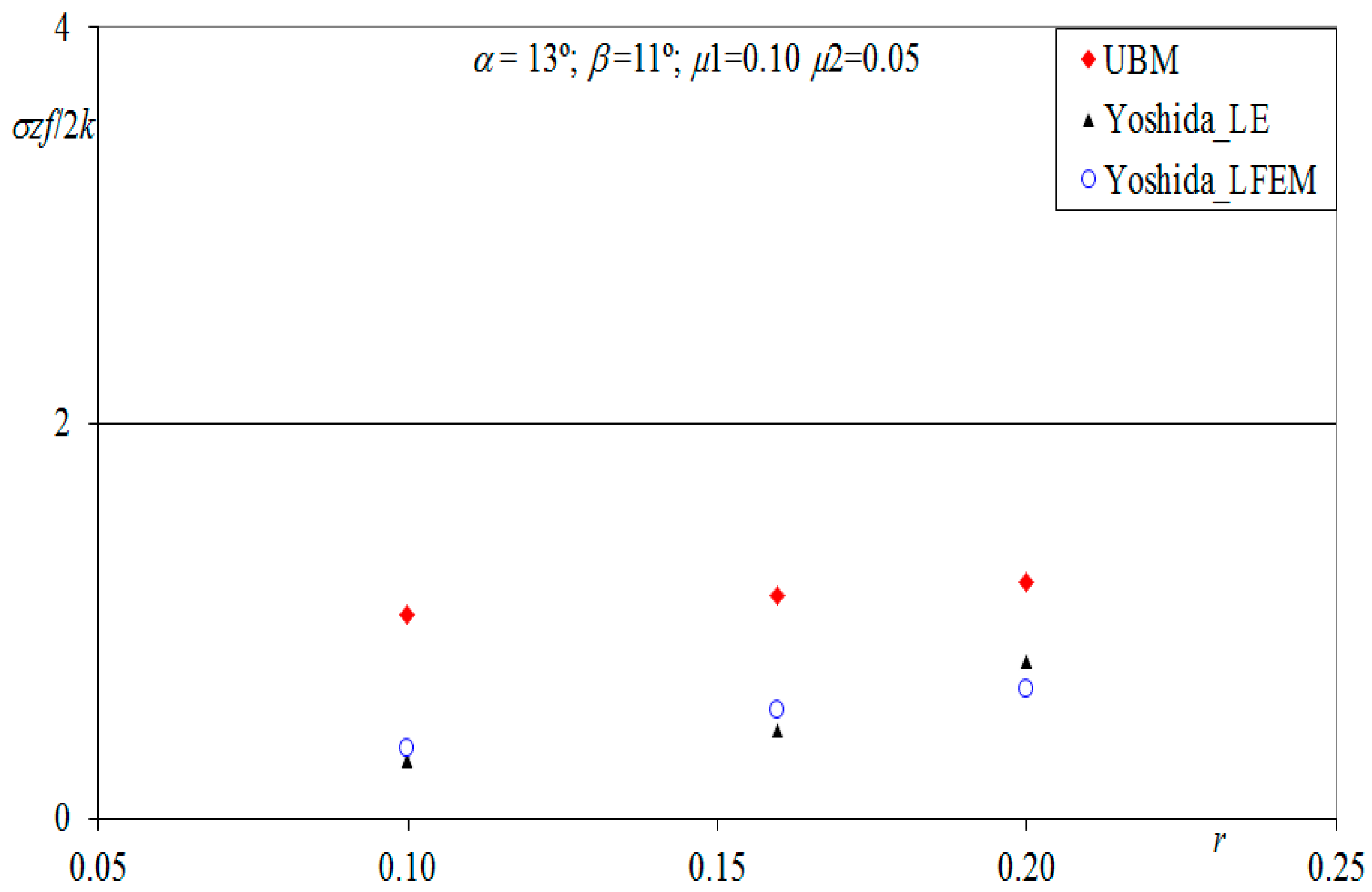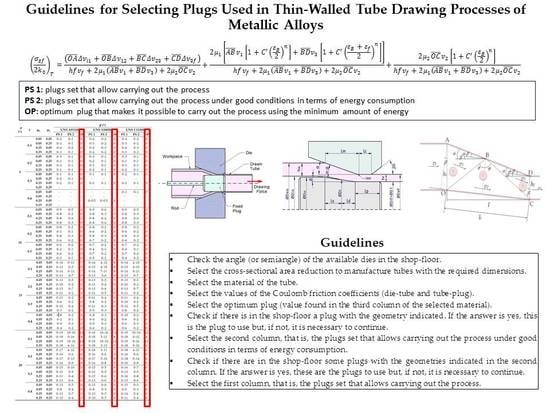1. Introduction
Axisymmetric drawing is extensively used in the industry for manufacturing different kind of components, mainly in the shape of bars/rods, wires, and tubes. In the last decades, a lot of research has been developed in order to analyze this group of metal forming processes and particularly their main characteristics and interrelations between the variables involved. Thus, Celentano et al. [
1] have analyzed the mechanical behaviour of steel rods during multiple-step wire cold-drawing processes by numerical and experimental techniques, assessing the influence of the number of wire reductions and the presence of back tension on the material response during the process. The influence of back tension was also studied by the authors in their previous work [
2]. Another study [
3] was focused on obtaining the drawing stresses required to carry out the process, modelling wire and plate drawing operations by an analytical method such as the slab method (SM) and a numerical one such as the finite element method (FEM). The results were also compared with results found in the literature [
4,
5,
6,
7,
8,
9,
10,
11,
12,
13,
14,
15,
16,
17,
18,
19,
20,
21,
22,
23,
24,
25,
26,
27,
28,
29,
30,
31], particularly with Wistreich’s experimental solutions in wire drawing and with Green and Hill and the upper bound technique in plate drawing. The work of Vega et al. [
4] investigated the effect of the process variables such as semi-die angle and reduction in area, and the coefficient of friction on the drawing forces of copper wires, paying attention to the die design in order to obtain the best quality of wire. Some other studies have focused on analyzing the influence of geometrical conditions on the appearance of internal defects such as the well-known central burst or chevron crack [
5]. In the work of McAllen and Phelan [
6], they presented a modified damage model that was implemented into a finite element model using a Fortran subroutine that enabled the analysis of the occurrence of central burst defects in single and multipass wire drawing operations. Weygand et al. [
7] demonstrated the influence of residual stresses in the occurrence of longitudinal cracks (splits) in tungsten wires.
Nevertheless, drawing processes remain as a field of huge interest in view of the variety of works that are being published nowadays on the basis of new emerging approaches. Thus, Haddi et al. [
8] have analyzed the influence of drawing conditions on temperature rise and drawing stress in cold drawn copper wires; Lambiase and Di Ilio [
9] have studied the deformation inhomogeneity of flat wires produced by roll drawing processes; Panteghini et al. [
10] have determined the effects of the strain-hardening law in the numerical simulation of wire drawing processes in their work of 2010. An important group of studies are focused in the analysis of residual stresses of the drawn parts, as in the work of Toribio et al. [
11], who have studied the influence of residual stress and plastic strain distributions in wires under different drawing conditions (inlet die angle, die bearing length, varying die angle, and straining path) on their hydrogen embrittlement susceptibility, the residual stress redistribution induced by fatigue [
12], and the role of overloading on the reduction of residual stresses in cold-drawn pre-stressing steel wires [
13]. The reduction of tensile residual stresses during drawing has been also studied by Ripoll et al. in their work of 2010 [
14], considering as application tungsten wires.
There is also a high interest in investigating some related phenomena that can be a problem when the component produced is under service conditions, such as damage induced in the drawn parts [
15] or evolution of surface defects [
16], and, of course, the study of the effects of friction phenomenon and related aspects such as die wear and lubrication [
17]. Besides the finite element simulation and experimental testing, the development of analytical methods is an active field as well [
18]. Analytical modelling of the hydrodynamic drawing process is proposed in [
19], analyzing the effect of the geometry of workpiece and die, the work hardening effects of materials, and fluid properties to determine the fluid film thickness, concluding that a stable fluid film can be established for low drawing speeds combining both a multiple reduction die and a supply of lubricant at high pressures to the inlet of the dies. The microstructural behaviour of drawn parts [
20] and the size effects at micron scale are also fields of study [
21] and there are also new works that consider a multi-objective approach of analysis, taking into account process forces, die wear, material thinning, and damage [
22]. As it can be seen after the literature review, most of these works are focused in fabrication of solid profiles, but there is a lack of information regarding drawing of tubes.
Metallic tubes are usually used in a great number of industrial sectors such as aerospace, defense, medical, transport and nuclear industries, to name but a few. Obtaining such types of pieces, in particular thin-walled ones, usually involves a cold finishing process in which the tube is drawn through a die until its diameter, the thickness of its wall, or both reach values of supply standard [
23,
24]. Usually, mandrels and plugs are located inside the die in order to achieve a more accurate dimension of the inner diameter of the tube [
25].
Figure 1 shows the tube drawing process with a plug, fixed by a rod (a) and floating (b).
Tube drawing process in convergent conical die with fixed conical inner plug fixed to the draw bench is the process analyzed in this work. The tube inner diameter is going to be considered constant along the process. Then, the initial and final inner diameters (
and
, respectively) can be considered constant along the process and of value
(
≈
≈
), varying only the thickness from an initial value of
to a final one of
, as illustrated in
Figure 2.
The thin-walled tube drawing process with a fixed conical inner plug can be considered that occurs under plane strain conditions since there is no appreciable variation of its inner diameter (
≈
≈
), as indicated above. According to Hill [
26], these conditions represent a material under shear stress state in which the material flow takes place as a result of the denominated shear yield stress,
. In addition, a superposed hydrostatic stress, generally of compression, can exist. This stress alters the values of the principal stresses
and
, but does not influence the material flow [
23].
However, the metal at the die exit is free to undergo transverse or circumferential strains, as indicated in several classical handbooks on metal forming and plasticity [
27,
28,
29] because it is in a state of uniaxial stress rather than of plane strain. That makes some authors recommend the plug to be slightly larger than necessary to obtain the precise dimensions of the tube [
25] and constitutes the real limit of the tube drawing, since the strength that finally limits the last pass is the uniaxial yield stress,
, and no the yield stress under plane strain,
. Although the plane strain conditions stay in the real deformation zone, such limit represents the instability of the material under tension and comes given by
where
represents the limit of instability of the material under tension (Limit-IMUT).
The process variables related to the geometry are the conical convergent die semiangle
, the fixed conical plug semiangle,
, place inside of the die; and the tube cross-sectional area reduction,
, defined by an equation obtained in a previous work [
23].
On the other hand, the existing friction between the interfaces die-tube outer surface and plug-tube inner surface has been considered of Coulomb type and with values of the Coulomb friction coefficients and , respectively.
This paper, focused on the thin-walled tubes drawing processes with a fixed conical inner plug, gives some interesting guidelines to select the plug or set of plugs more adequate to carry out the finishing process described above, considering the tube material, the most relevant geometrical factors of the problem, and the friction conditions. The analysis is carried out by means of the upper bound method (UBM), modelling the plastic deformation zone by triangular rigid zones (TRZ), and considering that the process occurs under plane strain and Coulomb friction conditions. A two-dimensional finite element model is designed to validate the results obtained by the analytical method. In addition, the model has been validated by other finite element method (FEM) simulations and real experiments taken from other researchers found in the literature [
30,
31] (called literature simulations and literature experimental results, respectively).
4. Conclusions
This paper, focused on drawing processes of thin-walled tubes carried out with fixed conical inner plugs, gives some practical guidelines to select the plug or set of plugs more adequate to perform the cold finishing process in which the tube is drawn through a die, until that its diameter, the thickness of its wall, or both reach values of supply standard.
The analysis is developed by means of the upper bound method (UBM), modelling the plastic deformation zone by triangular rigid zones (TRZ), and considering that the process occurs under plane strain and Coulomb friction conditions. The UBM has been validated by conducting a finite element analysis (FEA) of different cases under different process conditions and results show a good agreement in all cases.
In addition, the results have been compared with others, both of simulations by finite element method (FEM) and experimental ones, found in the literature about the theme. From this comparison, it can be seen that the results obtained by the UBM follow the same trend, being higher than all of them, as it was expected, since this method provides an upper limit.
The study has allowed establishing for each material and combination of the variables and of the friction conditions a first set of plugs that allows carrying out the process (PS1), a second set of plugs that allow carrying out the process under good conditions in terms of energy consumption (PS2), and the optimum plug that makes possible to carry out the process using the minimum amount of energy (OP). Therefore, the best would be selecting the optimum plug in order to perform the process with the lower energy as possible. However, in the shop-floors all the plugs are not always available since they are very costly, and they are not bought in all sizes or, even although there are among the resources of the shop-floor, in this moment, it can be possible that they are being repaired or under maintenance. Then, in many cases, it will be necessary to use other available plugs to obtain the products to satisfy the customers in the agree deadlines. The guideline step to step to select the most adequate plug in each case is
- ▪
Check the angle (or semiangle) of the available dies in the shop-floor.
- ▪
Select the cross-sectional area reduction to manufacture tubes with the required dimensions.
- ▪
Select the material of the tube.
- ▪
Select the values of the Coulomb friction coefficients (die-tube and tube-plug).
- ▪
Select the optimum plug (value found in the third column of the selected material).
- ▪
Check if there is in the shop-floor a plug with the geometry indicated. If the answer is yes, this is the plug to use but, if not, it is necessary to continue.
- ▪
Select the second column, that is, the plugs set that allows carrying out the process under good conditions in terms of energy consumption.
- ▪
Check if there are in the shop-floor some plugs with the geometries indicated in the second column. If the answer is yes, these are the plugs to use but, if not, it is necessary to continue.
- ▪
Select the first column, that is, the plugs set that allows carrying out the process.
Check if there are some plugs in the shop-floor with the geometries indicated in the first column. If the answer is yes, these are the plugs to use; if not, it will not be possible to carry out the process in the shop-floor. Then, to carry out the process, it is necessary to buy a plug (if possible, the optimum one).
From the analysis of the behaviour of all them, it is possible to establish that the plug that allows carrying out the process with minimum quantity of energy is cylindrical in most cases ( = 0°), being conical only for low (0.10) and medium (0.20) cross-sectional area reductions and certain combinations of the Coulomb friction coefficients ( and ) for die semiangles, , bigger than 10°.
Practical applications of the tube drawing processes can be improved with this study since it provides, in a simple and economic way, an adequate and enough knowledge for technological decision-making based in the energy required to carry out the process; such as machines, dies and, in particular, about the plug selection.
